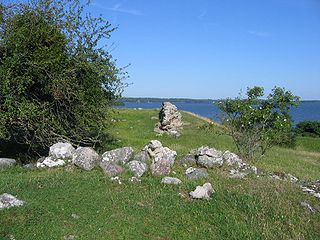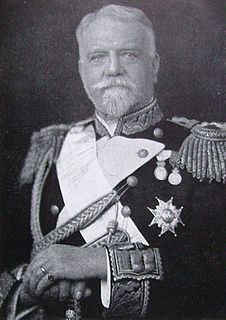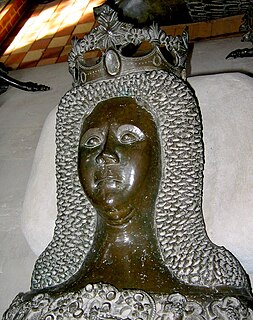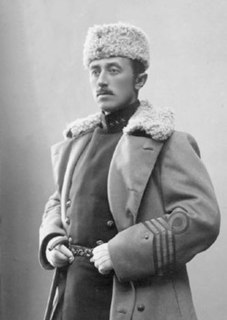
The Swedish nobility has historically been a legally and/or socially privileged class in Sweden, and part of the so-called frälse. The archaic term for nobility, frälse, also included the clergy, a classification defined by tax exemptions and representation in the diet. Today the nobility does not maintain its former privileges although family names, titles and coats of arms are still protected. The Swedish nobility consists of both "introduced" and "unintroduced" nobility, where the latter has not been formally "introduced" at the House of Nobility (Riddarhuset). The House of Nobility still maintains a fee for male members over the age of 18 for upkeep on pertinent buildings in Stockholm.
Brahe is the name of two closely-related Scanian noble families who were influential in both Danish and Swedish history.
Adlercreutz is a Finnish, Swedish and Danish noble family. Its oldest known ancestor is Swedish speaking Finn, Erik Markusson, dead 1654, who was a farmer in Biskops, Iso-Teutari, Lohja, Uusimaa, Finland ]. His son Tomas Eriksson Teuterström 1643–1710) served king Charles XI and Charles XII in the Treasury and was knighted on 26 September 1700 in Karlshamnby King Charles XII of Sweden with the name Adlercreutz, and was introduced at Swedish House of Nobility, Riddarhuset in 1703 with the number 1382, which has later been changed to 1386 B.
The title of King of the Goths was for many centuries borne by both the Kings of Sweden and the Kings of Denmark.

Lidströmer is a Swedish noble family, originating from the village of Liden, Medelpad, Sweden. Knighted 3 October 1800 by King Gustav IV Adolf in Stockholm Palace, Sweden. Jonas Lidströmer (1755–1808) was noblised on the grounds of his great innovations during late 18th century

Duchess Louise Charlotte of Mecklenburg-Schwerin was the maternal grandmother of Prince Albert, husband of Queen Victoria of the United Kingdom.

Count Carl August Ehrensvärd was a Swedish Navy admiral, politician and Minister for Naval Affairs 1907–1911.
Adlersparre is a Swedish noble family, which is descended from the mayor of Bogesund Christopher Andersson, who was active during the earlier half of the 17th century.
Adelsköld is the surname of a noble Swedish family.
Adelswärd is a Swedish Baronial family, descended from the Hultman line of the extinct noble family Adelswärd. The titular governor Johan Adelswärd (1718–1785) was created a Swedish Baron 11 December 1770 at Stockholm Palace by King Gustavus III of Sweden, and was introduced 12 December 1771 at Riddarhuset as Baronial family number 249, thus making the noble family Adelswärd extinct. The just mentioned Johan Adelswärd founded the fee tail Adelsnäs, which constitutes the "Barony Adelswärd", the only one of its kind in Sweden.
The comital family Adelswärd is descended from the Baronial family Adelswärd. Baron Eric Reinhold Adelswärd (1778-1840) was created a Swedish Count 19 June 1823 at Stockholm Palace by King Charles XIV John of Sweden, in accordance with the 37th paragraph of the instrument of government of 1809, meaning only the head of the family would be a Count. He was introduced at Riddarhuset 1 June 1825 as comital family number 138. His son Eric August Adolph Adelswärd (1817-1853), who became a Count at the death of his father, abandoned the title with royal permission 30 November 1840 for him and his issue, thus making the comital family extinct.

Euphemia of Pomerania was Queen of Denmark as the spouse of King Christopher II. She was the daughter of Bogislaw IV, Duke of Pomerania, and his second spouse, Margarete of Rügen.

Gustaf Vilhelm Emanuel Swedenborg son of lieutenant colonel Gustaf Erik Oscar Swedenborg and Maria Therése Fock, was a member of the Swedish military and an aeronaut, today remembered as a reservist on Salomon August Andrées failed Northpole-expedition in 1897 and for being one of the first Swedish balloonists. He was also the first person to hold an aeronautical certificate in Sweden, issued in 1905.

Beate Clausdatter Bille was a Danish noblewoman, a member of the royal court, Chief Lady-in-Waiting to Queen Sophie from 1584 to 1592, the wife of statesman Otte Brahe, and a feudal fiefholder in her own right following the death of her husband. She succeeded her sister-in-law Inger Oxe, who held the office from 1572 to 1584, as Chief Lady-in-Waiting to Queen Sophie. Beate Bille was the mother of astronomer Tycho Brahe.

Walter Magnus Runeberg (1838–1920) was a Finnish neo-classical sculptor.

Philip von Saltza was a Swedish-born American artist and muralist.
Court Mistress or Chief Court Mistress is or was the title of the senior lady-in-waiting in the courts of Austria, Denmark, Norway, the Netherlands, Sweden, Imperial Russia, and the German princely and royal courts.

Ida Marie Bille (1822-1902) was a Danish courtier; Overhofmesterinde to the queen of Denmark, Louise of Hesse-Kassel, from 1864 to 1876.
Carl Oscar (Oskar) Boije af Gennäs, born 7 July 1849 in Hasslöv's parish in Halland county, died 1923 in Hedvig Eleonora's parish in Stockholm, was a Swedish mathematician and collector of sheet music for guitar.












